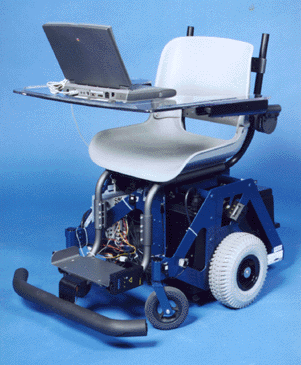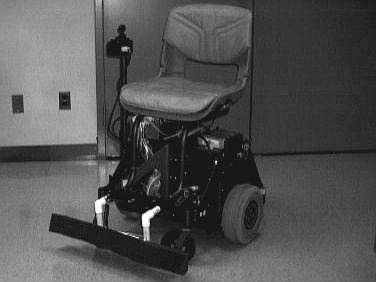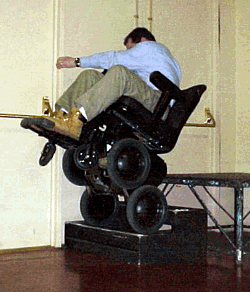
Team: 04-0001
 |
|
The Present One of the most commonly overlooked applications of robotics, and yet one with a great amount of potential, is the ability to help physically disabled people. An obvious aspect of this is using robots to assist the mobility-impaired. Even those with disabilities may someday walk wherever they like, aided by purpose-built robotic devices. Researchers are drawing upon the vast knowledge base of past experiences with assistive technology and robotics and have begun to add truly robotic powers to wheelchairs and other devices in order to expand their mobility. Research at MIT, the KISS institute and other universities and corporations is concentrating on allowing robotic chairs to make decisions for the user without the user intervening.
In the mid 90's Holly A. Yanco and James Gips of the famed MIT AI lab and Computer Science department developed a semi-autonomous wheelchair named Wheelesley[13]. The actual wheelchair was built by the KISS institute [6], the software and user interfaces were designed at MIT. The wheel chair was designed for those people who may not be able to use a standard joystick controlled motorized wheelchair. The system uses electrodes placed upon the users head to track the position of the users eyes. This system is called "Eagle Eyes" [14]. These electrodes are attached to a standard laptop computer and a camera. The user may then issue high level commands to the wheelchair such as "go forward" the wheelchair then performs low-level navigation for the user and avoids obstacles for the user. Wheelesley may be used either indoors or outdoors and the wheelchair can determine on its own if it is indoors or outdoors. The robot is under continuous development. The wheelchair still requires input and control from the user and cannot operate fully autonomously.
The Tin Man wheelchair maneuvers itself around objects around the house. It is good for blind people; the walking stick is now yesterdays technology and so is the regular manual wheelchair. The Tin Man helps people who do not have fine motor skills to maneuver themselves around. Also, people with impaired vision can benefit from this invention.
The Tin Man has a controller that can be attached to any other standard movable wheelchair. The controller is made by the KISS institute in Norman, Oklahoma[6]. The controller attaches to the motorized wheelchair giving it semi-autonomous capabilities allowing it limited sense of the outside world. The controller is also extremely inexpensive compared to a wheelchair designed from the ground up as a robotic chair. The controller is only a few hundred dollars [6]. However, the controller and chair are only semiautonomous in nature.
Although not an autonomous robotic device, the IBOT designed by Dean Kamen is designed to carry handicapped people over terrain that would completely defeat normal wheelchairs[7]. The incredible advances of today's IBOT can be used incorporated into robotic devices in the future. Using special sensors to help it balance, it can travel over sand and gravel, climb stairs, and even raise itself to reach the top of shelves[8]. To top it all off, the IBOT balances on only two wheels—a feat comparable to the first humans walking erect. This amazing machine takes giant steps towards allowing mobility-impaired people to move normally.
The devices used to run Kamen’s IBOT are similar to another of his inventions, the Segway. While the Segway is designed to transport able-bodied people, the IBOT balances using the same principle. Gyroscopic tilt sensors are filled with an electrolyte fluid like the fluid that your inner ear uses to balance, informing the machine if it is leaning. The sensors are connected to multiple microprocessors that run checks over 100 times a second. If there is a sudden shift in weight, the processors adjust the motor speed to keep the machine upright. With computerized checks running the IBOT, its reaction time easily exceeds that of humans. None of these innovations come at the expense of its power, either. The IBOT can outperform a marathon runner up inclines and adjust to stay upright even when a 20-pound weight is thrown at it. Wearing one of these, even disabled people can surmount curbs and steps without problem. Dean Kamen’s incredible invention and the others on this page prove that if you look at today’s brightest minds, you can see that the future is closer than ever before. |


